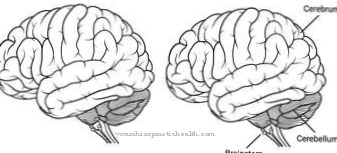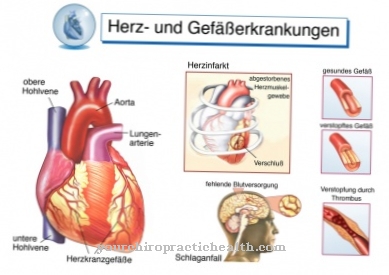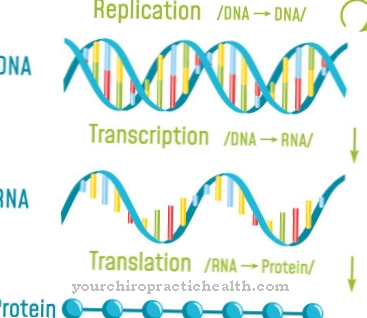A Abdominal muscle strain is a minor injury to the abdominal muscles. Athletes are particularly affected. The abdominal muscle strain can heal quickly with suitable measures.
What is an abdominal muscle strain?

© bilderzwerg - stock.adobe.com
An abdominal muscle strain is a strain on the skeletal muscles in the area of the abdomen. The abdominal muscles work together with the back muscles and are made up of straight and oblique muscles.
The straight muscles create good posture and allow the upper body to lean forward. The oblique abdominal muscles allow you to turn sideways. The skeletal muscles consist of different building blocks. The smallest unit of these building blocks are the sarcomeres. When subjected to excessive stretch, these muscle fibers can become pulled and tear. This affects the functioning of the muscles.
Abdominal muscle strains often arise during exercise. The signs are pain in the muscles. However, this pain is less than with torn muscle fibers and torn muscles. When pulled, only the smallest unit of the muscle is affected. Nevertheless, the muscle should be spared.
causes
The cause of an abdominal muscle strain can be an overuse of the muscles of the abdominal area by incorrect movement or by stretching the muscles too much. The sarcomeres of the muscles cannot withstand excessive stretching and tear.
A previous injury to the muscle that has not healed can also result in an abdominal muscle strain. It is therefore important to protect the muscles so that regeneration can take place.
Abdominal muscle strain can also result from great physical exertion. Immediately afterwards there is pain in the abdominal area. Since the abdominal muscles create a squeeze, it can also cause pain when coughing or when using the toilet.
Sports with varying muscle loads can be another cause of the abdominal muscle strain. One could think of sports such as soccer, tennis or sprinting. These sports not only involve quick movements, but also quick stops. This overworks and tires the muscles.
An inherently low ability of the muscles to stretch is also an option. Finally, an imbalance in the muscles in the spine can be the cause of an abdominal muscle strain. Some muscle parts are overloaded because they have to balance the imbalance.
You can find your medication here
➔ Medicines against tension and muscle painSymptoms, ailments & signs
An abdominal muscle strain is often the result of an unusual overload, so that the muscle in question is pulled. A common symptom of such an abdominal muscle strain is a sharp pain that is noticeable even when you are resting. With certain movements, these complaints can increase considerably, as an improvement can only be achieved through sufficient rest and protection.
If the affected person feels a sharp pain in the abdomen when breathing in and out, then this is also a very clear sign of an existing abdominal muscle strain. If you continue to strain the abdominal muscles, you may have to reckon with an abdominal muscle tear. Thus, an extensive rest phase is very important and useful if you have an existing abdominal muscle strain.
Under certain circumstances, an abdominal muscle strain can also spread to other parts of the body if an actual muscle tear should occur. Swelling in corresponding regions can be the first signs of an abdominal muscle tear. In such a case, a visit to the doctor should not be put off on the back burner if a prompt and quick healing is to be achieved.
Diagnosis & course
The main indicators for an examination are increasing pain in the abdominal muscle area. In addition to these symptoms, decreased mobility and restricted function of the area can occur.
Other indications are muscle cramps and a hardened muscle. Because the tone is increased in this area, the doctor will check the muscle hardness and tenderness. Another important point is whether the patient is comfortable with stretching and uncomfortable with tension. An imaging procedure is ruled out for diagnosis because the abdominal muscle strain does not damage the muscle fibers.
First of all, a sudden pull is felt when the abdominal muscle is pulled. Later on there is severe pain, especially when moving. The pain is caused by an inflammatory reaction and is usually cramp-like. It is characteristic that the symptoms increase slowly. The muscle area can still be used at first, not later. The muscle hardens and cramps increasingly.
Complications
An abdominal muscle strain usually results in relatively severe pain. This pain is exacerbated because the patient uses these muscles every day and can hardly prevent their use. Because of this, these muscles take longer to rehabilitate. Often there are painful cramps and also tenderness.
As a result of the abdominal muscle strain, the person affected also feels a pulling in the abdomen, which can spread to the abdomen. In some cases, the abdominal muscle strain causes inflammation of the abdominal muscles, which is treated with medication. In the case of a strain, the patient is severely restricted in his movement and thus in everyday life. This significantly reduces the quality of life.
When treated with medication, the inflammation is fought so that there are no further problems. The symptom itself can be treated with bandages, bandages, and cooling. In most cases, the treatment leads to a positive course of the disease and no further complications arise.
If the abdominal muscles are strained even further after the abdominal muscle strain, the result is usually unbearable pain and cramps.
When should you go to the doctor?
An abdominal muscle strain does not need to be treated in every case. In many cases, the symptoms will go away on their own if the strain was not severe. However, a doctor should be consulted if the abdominal muscles are sore or stiff.
If there is cramps or swelling in the affected areas, the person affected should see a doctor. It is not uncommon for pressure pain to occur and significant pain when moving the abdomen slightly. Since the symptoms significantly reduce the quality of life of the person affected, a doctor should be consulted if the symptoms of the abdominal muscle strain do not go away on their own.
In many cases, the patient has various options for self-help to alleviate the symptoms of the abdominal muscle strain. In acute emergencies or after an accident, the hospital should be visited or an emergency doctor should be called directly. A general practitioner can also be consulted for diagnosis. Further therapy then takes place with a sports doctor or through physiotherapy.
Doctors & therapists in your area
Treatment & Therapy
Since the muscle tissue is not damaged in the case of the abdominal muscle strain, the main aim of the treatment is to combat the symptoms. Recovery is important, not muscle renewal. The malfunction of the muscle associated with the complaints is compensated. In addition, the muscle is relieved and relaxed. Physiotherapy treatment is suitable.
If you suspect an abdominal muscle strain, all activities should be stopped so that the muscle can regenerate. Treatment is initiated with the so-called PECH scheme. This means: P stands for a pause in the body area. There is a pause even after a slight pull. Strong pressing should also be avoided. The E stands for ice and other means with which a cooling of the muscle area can be achieved. The cooling helps reduce pain.
The C stands for "Compression". Compression, in turn, means applying pressure to the painful area using pressure bandages. The bandage strengthens the muscle and at the same time protects it. However, the pressure bandage should not be pulled too tightly so that it does not impair blood vessels and nerves. Cooling sleeves are very suitable because they combine pressure and cooling.
Finally, the H stands for high camps. Because by storing it up, less blood is transported into the injured tissue. This reduces the tone, i.e. the feeling of tension. After treatment according to the PECH scheme, the patient can take a hot shower or go to a sauna.
Outlook & forecast
An abdominal muscle strain occurs when the muscles in the abdomen are stressed too much. Certain postures and movements cause stabbing pain in the abdominal region, so that the person affected is very limited in everyday life. If such a clinical picture is left completely without medical and drug treatment, then the pain will increase considerably.
In particularly bad cases, an existing abdominal muscle strain can develop into an abdominal muscle tear, so that a visit to the doctor can no longer be avoided. Especially if the muscles in this area continue to be heavily strained, the likelihood of a tear in the abdominal muscles increases. Independent healing is no longer possible without medical treatment and medication. If the affected person decides to have such a treatment for an existing abdominal muscle strain, an uncomplicated and timely recovery can be expected.
With appropriate medication and a pronounced rest phase, a quick improvement can be achieved so that the abdominal muscles can be fully stressed again after around 10 days.However, maintaining a strict rest phase is not very easy, as this part of the body is already stressed with the simplest movements.
You can find your medication here
➔ Medicines against tension and muscle painprevention
As a preventive measure, do a warm-up exercise before exercising. It is especially important to warm up the muscles in cold weather. In addition, sports exercises should not be carried out in an uncoordinated manner or too quickly. As a preventive measure, you should drink enough water and pay attention to the electrolyte intake. Finally, a balanced diet is particularly important for athletes in order to avoid abdominal muscle distortion.
Aftercare
A strain of the abdominal muscles is usually a very painful affair, which does not always require medical or medication care. With light to moderate strains of the abdominal muscles, the healing process is completely independent. This means that all follow-up examinations can be dispensed with entirely. However, if there is severe abdominal muscle strain, a follow-up examination may be recommended.
If medical treatment was carried out in advance, follow-up examinations should not be dispensed with under any circumstances. Affected people often put stress on this sensitive region far too early, so that the abdominal muscle strain breaks out again. Exactly that can be prevented by subsequent investigations. An appropriate doctor can give the affected person appropriate medication and tips on the way so that such a strain on the abdominal muscles does not break out again.
If the abdominal muscles are severely pulled, one or, if necessary, several follow-up examinations should take place afterwards. This is the only way to prevent possible complications in the healing process. If the abdominal muscles are slightly strained, this can be completely dispensed with. Even without medical treatment or without subsequent examinations, there is no longer any obstacle to a full recovery. Nevertheless, if the slightest sign of aggravation, an appropriate doctor must be consulted.
You can do that yourself
If an abdominal muscle strain is suspected, all sporting activities should first be stopped. The actual treatment takes place according to the PECH scheme (pause, ice, "compression", elevation). Movements that could put additional strain on the abdominal muscles (e.g. pressing hard on the toilet) are ideally paused until the strain has healed.
To relieve the pain, the affected area should be cooled with ice and other cold applications. In addition, the distorted muscle must be tightened with compresses and pressure bandages and its blood flow promoted by elevation.
In addition to these immediate measures, hot showers or a short sauna session can help. In addition, the abdominal cavity can be rubbed regularly with rubbing alcohol, arnica tincture or marigold ointment. A decoction made from sage, hyssop and corn, which is also applied directly to the strain, has also proven itself.
After the acute phase, any pain and restricted mobility can be relieved through physiotherapy and electrotherapy. After a few days, light sports can be exercised again with an abdominal muscle strain. Cycling, swimming or walking promote blood circulation and loosen the affected muscles after a strain. If the symptoms persist despite all measures, you should see a doctor or sports medicine specialist with an abdominal muscle strain.


.jpg)

.jpg)






















